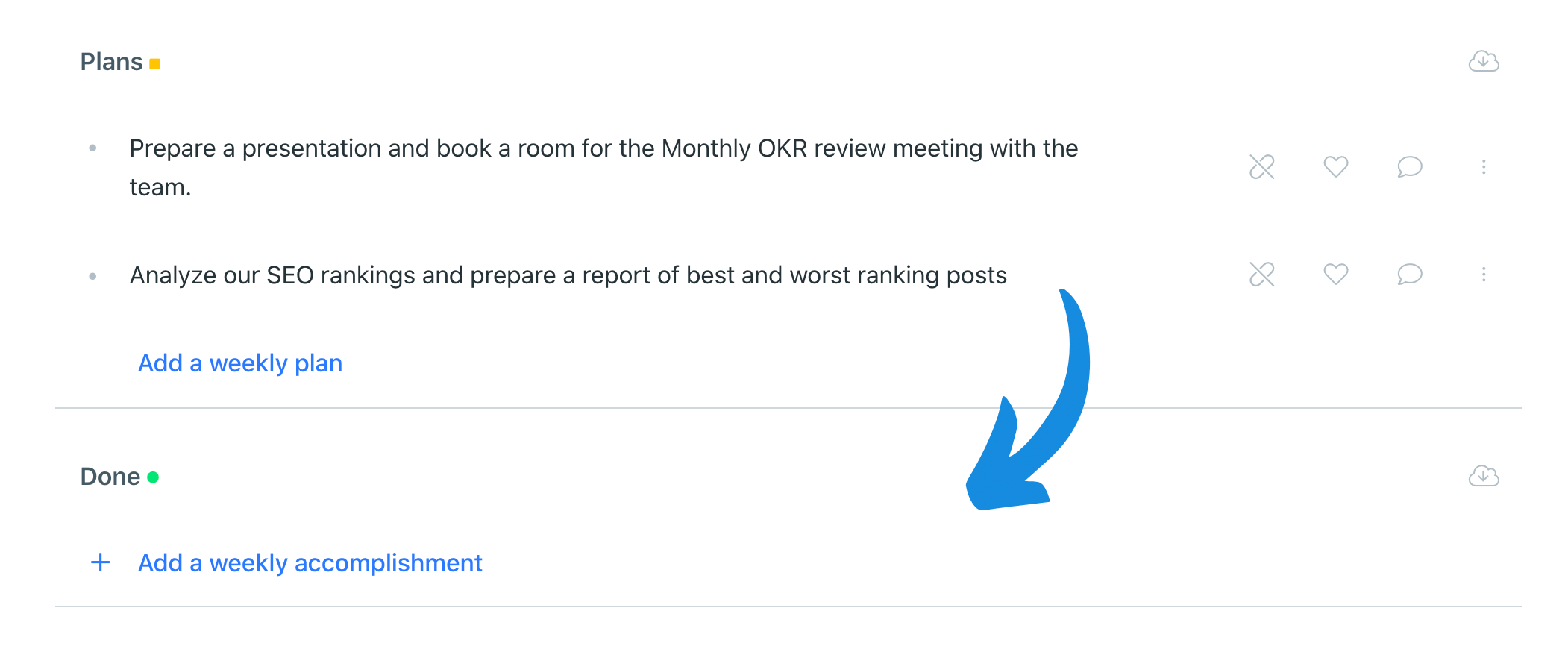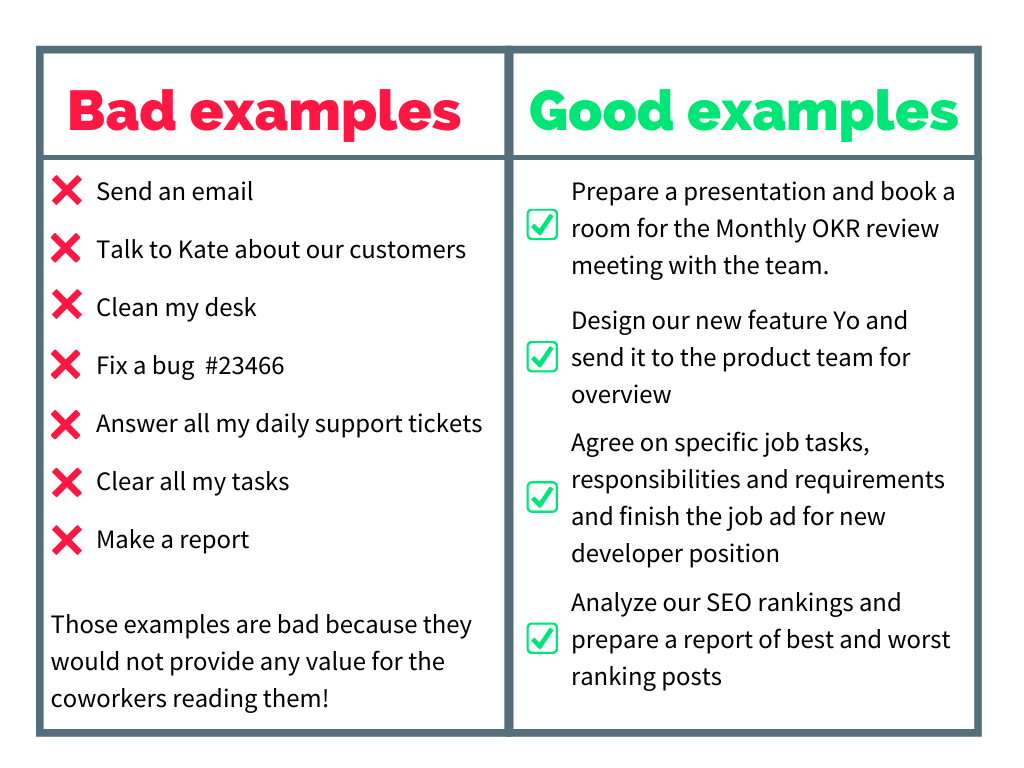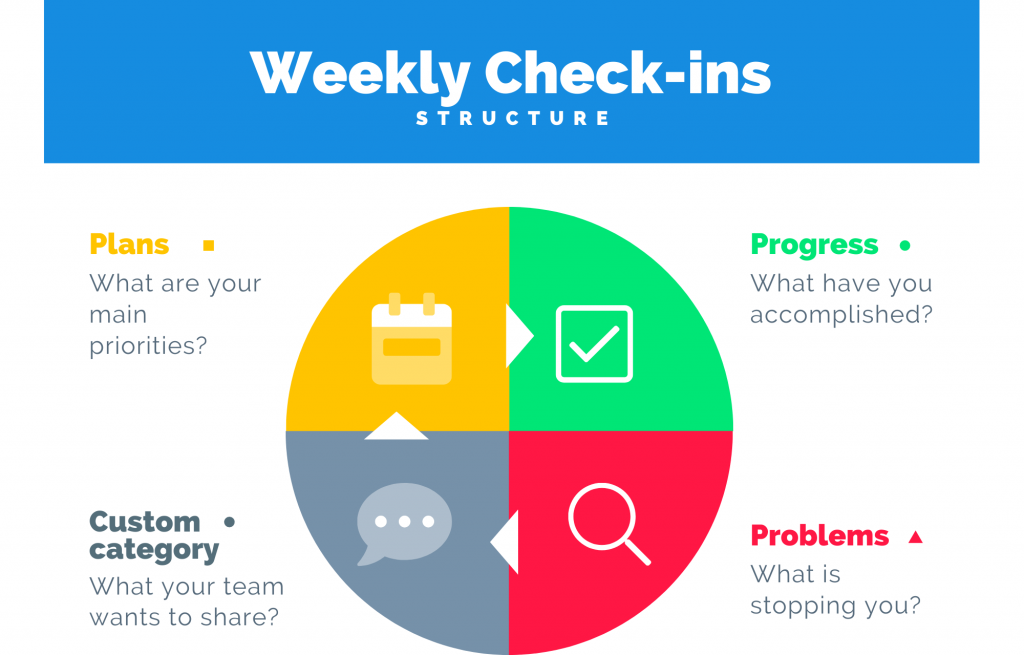Even beautifully written OKRs don’t achieve themselves. That is why every company should have an ongoing alignment process in place. Regular internal and cross-functional check-ins will help you achieve three things: save time in meetings, create a strong ownership culture, and learn how to achieve 80% of results with 20% of the effort.
In this article, we will discuss how these benefits come about and cover the most effective framework for weekly status updates, how to organize engaging OKR check-in meetings, and answer some frequently asked questions.
Benefits of the consistent weekly workflow
Achieving 80% of results with 20% of the effort sounds too good to be true. But how do we become good at anything? Simply by learning what works and what doesn’t. When you create a consistent weekly workflow and manage everyone’s expectations so that all team members know exactly what to do and by when, you streamline everyone’s effort in the right direction.
Better results are not just about setting the right goals, it’s more often about better management of the workload in the process of achieving those goals.
We are not born with goal-setting skills but everyone learns not to waste their time on things that don’t bring them any praise or recognition. The PPP process along with weekly check-ins will ensure that the recognition is given when it’s due and that everyone has a chance to ideate asynchronously by reading each other’s priorities in the Newsfeed.
The regular weekly feedback loop, continuous ideation, and keeping OKRs in front of everyone’s eyes is how you “Start Less and Finish More“.
Reporting format for weekly updates
The most efficient and widely used status reporting framework is the PPPs which stands for Plans, Progress, and Problems. It’s used by companies like Skype, eBay, and Facebook. We recommend implementing PPPs along with the OKR method because these 2 approaches complement each other very well.
How does the PPP framework help you?
Each person has their individual PPP form where they add their Plans, report on Progress, and share any Problems that occurred during the reporting period.
Each Plan is not a granular to-do but a personal outcome for the week. A to-do would be to “send an email to John” but an outcome for a week is to “set up an email drip campaign to improve the onboarding experience”. Some Plans would be weekly pieces of a larger Initiative that several people are working on together.
How to follow an effective PPP process?
-1- Add your Plans before the weekly check-in deadline. Link your Plans to Team OKRs if they are related.
-2- Before the next check-in, mark your Plans done by ticking the boxes or dragging them to the Progress section. If a Plan is half-done or needs more work next week, remember to leave a clarifying comment.
-3- Review the Plans and Progress items from other team members to catch up on the team’s progress before the weekly check-in.

If everyone on the team follows these three simple steps, you won’t need to organize status reporting meetings at all, and you can focus your time together on solving problems and making better decisions.
The rule of thumb is: whatever can be shared in written form, should be shared in written form.

How to organize engaging meetings
Regular weekly check-ins help everyone verbalize their commitment for a given time period – a week – and report on the actual output during the next check-in. This way you nurture the habit of setting realistic expectations for yourself and your colleagues, as well as become more conscious about things that you spend your time on.

Moreover, you are more likely to enjoy your work process if you know that you are contributing to the greater good of the team. And the team will surely be more likely to help you out in case you get stuck if they know what you are working on.
Best practice for internal check-ins
A weekly OKR check-in is a quick 15-20-minute meeting where you reflect on the progress of Team OKRs, present lessons learned (if any), and share new priorities for the upcoming week. If everyone shares their Progress and Plans in the PPP format in Weekdone, then you can spend this check-in meeting time solely on presenting the lessons learned, new priorities, and why they matter.
For example, if you published 5 blog posts last week, then, instead of repeating that you published 5 blog posts, you could share how those articles are performing and what, in your opinion, could be improved. Weekly check-in should not be about reporting but rather about understanding what kind of actions bring the progress of the OKRs and why.
| Meeting type | Weekly OKR Check-in |
| Purpose | Align the team and keep OKRs in focus |
| Participants | Team members working on this OKR |
| Scheduling | Once per week (choose a specific recurrent day and time) |
| Format for preparation | Review OKR progress in Weekdone, update KRs, leave comments; make sure your PPPs are up-to-date |
| Agenda | – Was there any progress on OKRs? – What is our prediction for next week? – What should we do differently? – What’s happening next week? – Any new initiatives that need a separate discussion? |
Best practice for cross-functional check-ins
In business, staying aligned means staying alive. Effective cross-functional collaboration could bring game-changing breakthroughs and make sure you outperform your competitors. But how do you keep the teams aligned throughout the quarter?
Watch these 2 short videos to pick up some tips on organizing a simple workflow for ongoing alignment.
Bonus tips + submit your own question
If you have a specific question about your own team or company, please send it to our inbox via okrcoaching@weekdone.com
Can we run the weekly check-in longer?
It’s simple. If this conversation affects everybody in the team and it is valuable information, then yes. This is under the assumption that no one else has anywhere to be as well. But you still have to be careful not to derail the conversation. There should be an outcome for every meeting you have. Repeating or arguing over things that everybody already knows doesn’t help anyone besides those who like the sound of their own voice. Also, most things can’t be solved by just discussing them. You need to try and gather feedback to see what works and what doesn’t.
Can we have OKR check-ins less often?
To be successful and achieve ambitious goals – definitely not. OKR check-ins are meant for the team members to reflect on what’s working and what’s not so you can set new Plans to accomplish good progress. If you have only one (or even three) meetings per quarter to do it, then you, likely, won’t have the time to analyze how the projects are going or check whether people are working on the right things.
Should we stop check-ins if we are failing on our OKR?
If the KR is not progressing, don’t immediately panic. The stagnant KR might not be the most important aspect of it. There are two questions you need to ask.
- First: did you learn something new?
- Second: was that information valuable?
If you can answer ‘yes’ to these questions, then the KR might have served its purpose without making any measurable progress. Maybe you picked a KR that is very hard to measure or maybe your KR doesn’t reflect the success of the Objective itself. Unless you didn’t learn any valuable lessons, you actually succeeded at something. As Thomas Edison said “I have not failed. I’ve just found 10,000 ways that won’t work.”
Keep recording lessons learned, and you will uncover unknown unknowns that will serve you well next quarter.
